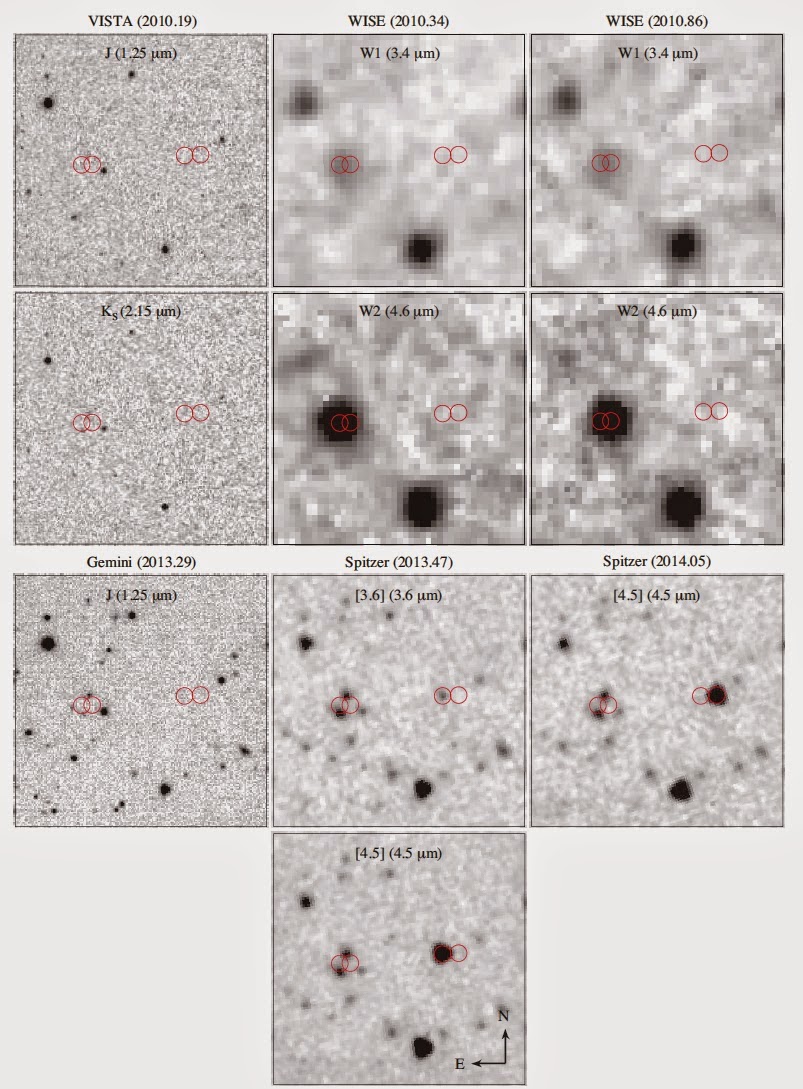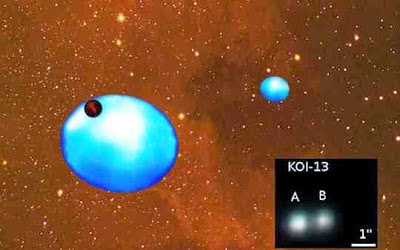Brown Dwarfs are objects intermediate to stars and planets in size;
they are not large enough to fuse ordinary hydrogen in their cores, but are
large enough to fuse the heavier isotope deuterium. These objects are thought
to be quite variable in nature, with the largest and warmest resembling small
Red Dwarf stars, but with cooler members of the group being more planet-like,
and potentially having solid surfaces, planet-like atmospheres and even ice
formation on their surface. Many of the Brown Dwarfs so far discovered are
companions to true stars, though they are rarer as companions than both
secondary stars and planets, with only a little over a hundred such companions
observed since the first discovery in 1995. The larger number of companion
stars discovered is easily explained, as such bodies tend to be easily visible,
but as the number of planets discovered in other stellar systems has risen
steadily it would have been expected that the number of Brown Dwarfs (typically
larger, brighter and easier to spot than planets) would have kept pace, yet
this has not happened.
In a paper published on the arXiv database at Cornell University
Library on 30 September 2014, and accepted for publication in the Monthly Notices of the RoyalAstronomical Society, a team of astronomers led by Robert De Rosa of the Schoolof Earth and Space Exploration at Arizona State University and the School of Physics at the University of Exeter describe the discovery of a Brown Dwarf
companion to the star ζ Delphini (Zeta Delphini) by the VAST (Volume-limted
A-Star) Survey using the Near InfraRed Imager and Spectrometer (NIRI) and
ALTitude conjugate Adaptive optics for the InfraRed (ALTAIR) systems on the
Gemini North telescope, with additional observations made by the Canada France Hawaii Telescope and the MMT Observatory.
ζDelphini is an A3V star (a blue-white star considerably more massive than the Sun) 220 light years from Earth in the constellation of Delphinus. It is thought to be
about 525 million years old with a mass of about 2.5 times that of the Sun and
an effective surface temperature of 8336K (compared to 5778K for the Sun). No debris disk has been found around ζ Delphini (visible debris disks
are associated with the early stages of planetary formation, though with an age
of 525 million years it would be predicted that any such disk in the system
would have dissipated) and the star has not been associated with any young
stellar group (group of young stars with similar trajectories and ages, thought
to share a common origin).
The new companion is named ζ Delphini B, making the original star ζ Delphini
A. It is estimated to be between 40 and 55 times as massive as Jupiter, and to
have an effective surface temperature of 1550K. ζ Delphini B is currently 912
AU from ζ Delphini A (i.e. 912 times as far from its parent star as the Earth
is from the Sun), though it is thought to have an eccentric orbit with an
average distance from the star of 907 AU, and an orbital period of about 10 000
years.
The Gemini/NIRI observation of the ζ Delphinisystem
obtained on 2010 June 8 showing the location of the heavily saturated ζ
DelphiniA, the substellar companion ζ Delphini B (zet Del B) and the seven background
objects (BG 1-7) used in the astrometric analysis (indicated by the arrows).
The image has been processed through a median filter to reduce the significant
amount of scattered light from ζ Delphini A. The orientation and angular scale
are given for reference; note that east and west are reversed in sky maps
relative to ground maps as one is looking up rather than down, and that the
scale is given in arcseconds (“) – the sky is divided into 360˚ (although only
180˚ is ever visible from any point on the Earth), with each degree (˚) divided
into 60 arcminutes (‘) and each arcminute divided into 60 arcseconds. De Rosa et al. (2014).
There are currently three theories as to how a star could come to
have a Brown Dwarf companion. The Brown Dwarf could potentially form as part of
a large circumstellar disk, in a similar way to a planet, though the formation
of a ~50 Jupiter-mass object at a distance of over 900 AU is improbable, both
because this would require a remarkable amount of matter at the thin outer-edge
of the circumstellar disk and because of the timescales that would be required
for the object to coalesce (things tend to move slowly in the outer parts of
stellar systems, as all motion is essentially driven by the gravity of the
star, and the ζ Delphini system is only thought to be 525 million years old),
however this possibility cannot be ruled out as it is possible that ζ Delphini
B formed much closer to ζ Delphini A, and has subsequently migrated outwards
due to gravitational interactions. Secondly it is thought possible that
sometimes young pre-stellar cores can be fragmented, producing two bodies
rather than one, though this is thought to be an extremely violent process,
resulting in two bodies separated by distances measured in thousands of AU
rather than hundreds. Finally it is possible that the two bodies formed separately
and that ζ Delphini B was subsequently captured by the gravity of ζ Delphini A,
though De Rosa et al. calculate that
such an occurrence is unlikely, given the weak gravitational force exerted by
the star at 900+ AU distances.
See also…
Brown Dwarfs are curious objects, intermediate between stars and
planets. They lack the mass to fuse hydrogen in their cores like true
stars, but are massive enough to fuse deuterium (a heavy isotope
hydrogen, containing one proton and one neutron in its atomic nucleus),
unlike planets. Brown Dwarfs therefore emit light in the infrared part
of the spectrum, rather than simply reflecting light like a planet;
though Brown Dwarfs within...
The KOI-13 system (Kepler Object of Interest system) comprises a pair of
A-type White Dwarf stars 1630 light years from Earth, orbiting each to
closely to be well differentiated. The larger of these, KOI-13α, has a
mass 2.05 times that of the Sun, the smaller, KOI-13β, has...
M Class stars, or Red Dwarfs, are the most abundant stars in the Galaxy,
and presumably the Universe. They are small (7.5-60% of the mass of the
Sun) and cool (2300-3800 K, compared to 5778 K for our Sun), but can be
very long-lived, as they burn their fuel slowly...
Follow Sciency Thoughts on Facebook.




